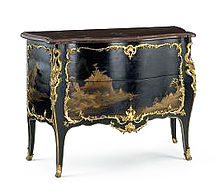| Revision as of 02:28, 13 March 2008 edit71.142.212.155 (talk)No edit summary← Previous edit | Revision as of 14:59, 13 March 2008 edit undoDino (talk | contribs)Administrators14,013 editsm Reverted edits by 71.142.212.155 (talk) to last version by 122.161.18.67Next edit → | ||
| Line 5: | Line 5: | ||
| The ] word ''commode'' comes from ] roots meaning "convenient" or "suitable". | The ] word ''commode'' comes from ] roots meaning "convenient" or "suitable". | ||
| Originally, in furniture it meant a ''']''', with |
Originally, in furniture it meant a ''']''', with one or more doors, which served as a ] with a ] and ]and which also offered an enclosed area below for storing a ]. Convenience cabinets called commodes often furnished middle-class bedrooms before the days of indoor plumbing. | ||
| See also: | See also: | ||
Revision as of 14:59, 13 March 2008
| This article does not cite any sources. Please help improve this article by adding citations to reliable sources. Unsourced material may be challenged and removed. Find sources: "Commode" – news · newspapers · books · scholar · JSTOR (April 2007) (Learn how and when to remove this message) |

A Commode is any of several pieces of furniture.
The English word commode comes from French roots meaning "convenient" or "suitable".
Originally, in furniture it meant a cabinet, with one or more doors, which served as a washstand with a washbasin and water pitcher, and which also offered an enclosed area below for storing a chamberpot. Convenience cabinets called commodes often furnished middle-class bedrooms before the days of indoor plumbing.
See also: Nightstand
This article about furniture or furnishing is a stub. You can help Misplaced Pages by expanding it. |